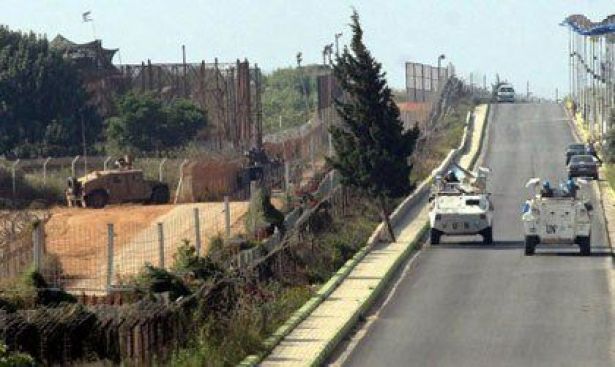Israeli wall rising near border with Lebanon stokes tensions
Associated Press/September 07/18
Last month, the Lebanese army complained to UNIFIL, the U.N. peacekeeping force, saying Israeli bulldozers working on the barrier were encroaching on the Lebanese side.
ROSH HANIKRA, Israel: Israel is building a massive wall along its northern border, saying the barrier is needed to protect civilians from Hezbollah attacks, but the project has raised tensions with Lebanon, which fears the fence will encroach on its territory.
The Israeli military insists the entire barrier is being constructed in Israeli territory, and the U.N. peacekeeping force in the area agrees. But Hezbollah has never fully accepted the border, and a senior Israeli military official stressed the need for the wall, saying that while Israeli intelligence closely monitors the militant group, “we are prepared for the possibility that they will surprise us.”
The official spoke on condition of anonymity under military guidelines during a military-led tour of the border region provided for reporters.
Israel’s military conducted a large-scale combined arms drill in northern Israel this week simulating a future conflict with Hezbollah, with which it fought a monthlong war in 2006. Israelis fear there could be a renewal of hostilities as the civil war winds down in neighboring Syria, where the Iran-backed militant group has been fighting alongside President Bashar Assad’s forces for the last seven years.
Hezbollah, which is considered a terrorist group by the U.S. and Israel, is believed to have an even larger and more sophisticated arsenal of rockets than in 2006, when it fought Israel’s vaunted military to a stalemate in southern Lebanon. That war began with a deadly cross-border raid in which Hezbollah killed eight Israeli soldiers and abducted two others, whose remains were returned to Israel in a prisoner exchange two years later.
ig. Gen. Eran Ofir, the commander in charge of Israel’s border wall projects, said around seven miles of the 80-mile (130-kilometer) barrier has been built. The $450 million project is slated for completion in two years. Most of the barrier is a concrete wall topped by steel mesh, sensors and surveillance cameras. Steel fencing replaces the concrete wall in especially rugged areas.
Earthmovers and other large machinery rumbled alongside a completed section of the 30-foot (9-meter) high concrete wall earlier this week near the Mediterranean coast. Lebanese soldiers looked over the barrier from a guard post on the opposite side of the Blue Line, which was demarcated by the U.N. after Israeli forces withdrew from south Lebanon in 2000 following an 18-year military occupation. The two countries technically remain at war.
Last month, the Lebanese army complained to UNIFIL, the U.N. peacekeeping force, saying Israeli bulldozers working on the barrier were encroaching on the Lebanese side. A Lebanese security official at the time said that following the Lebanese request, the Israeli bulldozers stopped their work and pulled back 50 meters (160 feet).
The U.N. Security Council warned last month that violations of the cease-fire agreement between Lebanon and Israel could lead to fresh conflict, and Lebanon’s top security body earlier this year described the planned border wall as an “aggression” against its sovereignty.
“This wall, if it is built, will be considered an aggression against Lebanon,” it said in a statement. “The Higher Defense Council has given instructions to confront this aggression to prevent Israel from building this so-called wall barrier on Lebanese territory,” it added.
Maj. Tomer Gilad, Israel’s liaison officer with UNIFIL, said there are monthly meetings with the Lebanese military and U.N. officials to coordinate the barrier’s construction.
“Even for the past year before we started this construction, we’ve coordinated this activity with UNIFIL, and through UNIFIL with the Lebanese Armed Forces. We’ve alerted them of our intention to do so, to construct this defensive mechanism,” Gilad told reporters.
r, construction has proceeded “very calmly with the participation on all sides to maintain the stability,” Gilad said. “We expect UNIFIL and the Lebanese Armed Force to maintain stability over here throughout this construction, because this construction is a stabilizing measure.”
UNIFIL spokesman Andrea Tenenti said that since construction began in February 2018, everything has been built south of the Blue Line and away from sensitive areas.
Israel says the barrier’s purpose is to defend Israeli communities from Hezbollah, pointing to sporadic cross-border attacks on Israeli troops and civilians in recent years. The volatile border between the two countries has been relatively quiet since the 2006 war, with few major cross-border attacks or incidents.
Israel warplanes, however, regularly violate Lebanese airspace, including to carry out airstrikes in neighboring Syria.
In 2010, an Israeli army officer was killed and another was seriously wounded when Israeli troops came under fire by Lebanese army forces while trimming trees on the Israeli side of the border. Three Lebanese soldiers and a Lebanese journalist were killed in Israeli retaliatory shelling. In 2013, an Israeli soldier was killed by a Lebanese army sniper while driving along the border, and in 2015 Hezbollah fired an anti-tank missile at an Israeli military convoy, killing two soldiers and wounding seven.
The Israeli official who spoke on condition of anonymity said the army has noticed a troubling rise in “very close cooperation between Lebanese Army Forces and Hezbollah” near the Israeli frontier in the past year. He says the military expects even more Hezbollah fighters to arrive in the area after the Syrian war ends.
With Hezbollah in Mind, Israel Builds a New Wall
إسرائيل تبني جداراً على حدودها مع لبنان يسبب توتراً
AFP/ Friday 07th September 2018
Security
High in the hills above the Mediterranean, Israeli troops worked while soldiers from a country still technically at war with them peered down from only metres above. The odd spectacle played out this week as Israel continued work on a new concrete wall along its northern border with Lebanon. A few Lebanese soldiers watched from a tower just on the other side. Israel has spent years building barriers to keep out Palestinians from the occupied West Bank and Gaza Strip as well as African migrants crossing from Egypt. Earlier this year, new construction began along the Lebanese border, where Israel is building a wall equipped with cameras in the hope of thwarting any attempt by its enemy Hezbollah to infiltrate and attack.
It follows up on earlier construction in 2012 of a wall around the Israeli town of Metula next to the Lebanese border.Israel says all portions of the wall will be on its side of the so-called blue line – the UN-established ceasefire line put in place after its withdrawal from southern Lebanon in 2000. But Lebanon says some sections will cut into its territory and earlier this year pledged a diplomatic push to prevent construction. Lebanon’s plans to explore for oil and gas offshore in waters eyed by both sides have added to the controversy. Israeli military officials told journalists during a tour of the work near the Mediterranean coast on Wednesday that the wall, replacing a fence, was being built for defensive purposes. Israel fought a war with Lebanon-based Shiite militant group Hezbollah in 2006.
The border area has remained relatively quiet since. “This obstacle basically relates to the intentions, the spoken intentions, the threats made public by Hezbollah since 2011, to infiltrate into Israel and to attack Israeli communities south of the blue line,” said Major Tomer Gilad.”We’re taking these threats seriously.”
NINE METRES HIGH
Israel has so far built 11km of the wall and a budget is in place for two more.The military hopes to eventually extend it some 130km, stretching the length of the frontier. If financed in full, work is expected to take two years, said project manager Brigadier General Eran Ofir. Military officials declined to comment on whether it includes underground components to detect and stop tunnel digging, as are being constructed along the border with the Gaza Strip. The total cost is expected to be 1.7 billion shekels (US$472 million).
It is designed to be some 9m (30 feet) high including steel mesh on top – similar to the wall that cuts off the West Bank from Israel. It is made of long concrete blocks, with tubes for technological components protruding. Israel’s military stresses it is closely coordinating the work with the UN peacekeeping force in Lebanon, UNIFIL.
Representatives of the Israeli and Lebanese armies meet roughly once a month, with UNIFIL mediating, to coordinate not only work on the wall but other issues that could lead to misunderstandings or clashes. and Lebanon have been involved in a series of conflicts over the years and the two remain technically at war.But the reason for the wall has less to do with the Lebaese army than Hezbollah, an Israeli military official said.
“NOT JUST WHAT YOU’LL SEE”
Tensions run deep between Israel and the Iranian-backed group. Hezbollah has been preoccupied with other issues in recent years, having sent several thousand of its fighters to back Syrian President Bashar al-Assad in his country’s civil war. It has lost many hundreds of fighters, including senior commanders, since it deployed in Syria, where the war is now winding down.
But from Israel’s point of view, it has gained as well by learning new tactics while fighting alongside Iranian and Russian troops, who are also backing Assad. Israel’s military believes Hezbollah has between 100,000 and 120,000 short-range missiles and rockets, as well as several hundred longer-range missiles. But the potential for shootings and infiltrations, as well as the need for surveillance, is the reason for the wall, it says. “It’s not just what you’ll see, the cement wall,” the senior Israeli military official said, adding there were components he could not talk about that make “what we can see from this much, much better.”





















